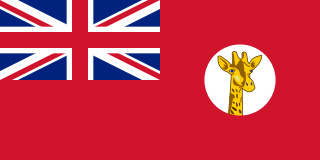
Tanzania, officially the United Republic of Tanzania, is a country in East Africa within the African Great Lakes region. It is bordered by Uganda to the northwest; Kenya to the northeast; the Indian Ocean to the east; Mozambique and Malawi to the south; Zambia to the southwest; and Rwanda, Burundi, and the Democratic Republic of the Congo to the west. Mount Kilimanjaro, Africa's highest mountain, is in northeastern Tanzania. According to the 2022 national census, Tanzania has a population of around 62 million, making it the most populous country located entirely south of the equator.
The modern-day African Great Lakes state of Tanzania dates formally from 1964, when it was formed out of the union of the much larger mainland territory of Tanganyika and the coastal archipelago of Zanzibar. The former was a colony and part of German East Africa from the 1880s to 1919 when, under the League of Nations, it became a British mandate. It served as a British military outpost during World War II, providing financial help, munitions, and soldiers. In 1947, Tanganyika became a United Nations Trust Territory under British administration, a status it kept until its independence in 1961. The island of Zanzibar thrived as a trading hub, successively controlled by the Portuguese, the Sultanate of Oman, and then as a British protectorate by the end of the nineteenth century.

Julius Kambarage Nyerere was a Tanzanian anti-colonial activist, politician and political theorist. He governed Tanganyika as prime minister from 1961 to 1962 and then as president from 1962 to 1964, after which he led its successor state, Tanzania, as president from 1964 to 1985. He was a founding member and chair of the Tanganyika African National Union (TANU) party, and of its successor, Chama Cha Mapinduzi, from 1954 to 1990. Ideologically an African nationalist and African socialist, he promoted a political philosophy known as Ujamaa.

Ali Hassan Mwinyi was a Tanzanian politician who served as the second president of the United Republic of Tanzania from 1985 to 1995. Previous posts included Minister for Home Affairs and Vice President. He also was chairman of the ruling party, the Chama Cha Mapinduzi (CCM) from 1990 to 1996.

Abeid Amani Karume was the first President of Zanzibar. He obtained this title as a result of a revolution which led to the deposing of Sir Jamshid bin Abdullah, the last reigning Sultan of Zanzibar, in January 1964. Three months later, the United Republic of Tanzania was founded, and Karume became the first Vice President of the United Republic with Julius Nyerere of Tanganyika as president of the new country. He was the father of Zanzibar's former president, Amani Abeid Karume.
Edward Moringe Sokoine was a Tanzanian politician who served two terms as Prime Minister of Tanzania, from 13 February 1977 to 7 November 1980 and again from 24 February 1983 to 12 April 1984.
Butiama is a town and capital of Butiama District, located in Mara Region in northern Tanzania. The town of Butiama is the birthplace of Julius Nyerere, the founding father and the first president of Tanzania. Butiama is also the homeland of the Zanaki people, of which the founding father was a member. The Mwalimu Nyerere Museum Centre is located in the town and is the town's biggest attraction.

The Uganda–Tanzania War, known in Tanzania as the Kagera War and in Uganda as the 1979 Liberation War, was fought between Uganda and Tanzania from October 1978 until June 1979 and led to the overthrow of Ugandan President Idi Amin. The war was preceded by a deterioration of relations between Uganda and Tanzania following Amin's 1971 overthrow of President Milton Obote, who was close to the President of Tanzania, Julius Nyerere. Over the following years, Amin's regime was destabilised by violent purges, economic problems, and dissatisfaction in the Uganda Army.
Godfrey Mwakikagile is a Tanzanian scholar and author specialising in African studies. He was also a news reporter for The Standard — the oldest and largest English newspaper in Tanzania and one of the three largest in East Africa. Mwakikagile wrote Nyerere and Africa: End of an Era — a biographical book on the life of former Tanzanian President Julius Nyerere set in the backdrop of Africa's early post-colonial years and the liberation wars in the countries of southern Africa in which Nyerere played a major role.

Tanganyika was a colonial territory in East Africa which was administered by the United Kingdom in various guises from 1916 until 1961. It was initially administered under a military occupation regime. From 20 July 1922, it was formalised into a League of Nations mandate under British rule. From 1946, it was administered by the UK as a United Nations trust territory.
Zanaki (Ikizanaki) is a Bantu language of Tanzania. It is spoken by the Zanaki people of Musoma and was the first language of Tanzanian president Julius Nyerere, son of the King Burito Nyerere (1860–1942).

Amir Habib Jamal was a Tanzanian politician and diplomat who served as a Minister under various portfolios in the Julius Nyerere administration. He represented the parliamentary constituency of Morogoro from 1960 to 1985, and was Tanzania's longest-serving Finance Minister and led the ministry for about 12 years.

Maria Nyerere served as the inaugural First Lady of Tanzania from 1964 to 1985. She was the seventh of nine children of Mr. Gabriel Magige, of Baraki, Tareme and his wife Hannah Nyashiboha.
John Mwakangale was one of the main leaders in the struggle for independence in Tanganyika during British colonial rule. When the country gained independence, Mwakangale joined the first cabinet of Julius Nyerere, the first President of Tanzania as Minister of Labour. Mwakangale is also regarded as a Pan-Africanist and a staunch African nationalist. He was also the first leader whom Nelson Mandela met in 1962 when he escaped from prison seeking assistance from other African leaders. Mandela gave a detailed account about that encounter in his book Long Walk to Freedom.
Jeremiah Kasambala was one of the first ministers in the cabinet of Julius Nyerere after Tanganyika won independence from Britain on 9 December 1961. He rose to prominence when he was the head of the Rungwe African Cooperative Union in Rungwe District in the Southern Highlands Province.
Charles Makongoro Nyerere is a Tanzanian CCM politician and a retired army officer of the Tanzania People's Defence Force. He is currently serving as a member of the East African Legislative Assembly.
David Bugozi Musuguri was a Tanzanian military officer who served as Chief of the Tanzania People's Defence Force from 1980 until 1988.
The Battle of Sembabule was a battle of the Uganda–Tanzania War that took place from March to 5/6 April 1979 in the town of Sembabule, Uganda. Tanzania had repulsed a Ugandan invasion in late 1978, and in early 1979 the Tanzania People's Defence Force (TPDF) crossed into southern Uganda. The Tanzanians decided shortly thereafter to attack the Ugandan capital, Kampala, and the 205th Brigade was detailed in early March to be sent north from Masaka and then west of the city. Ugandan President Idi Amin declared over radio that his forces were about to surround the TPDF, prompting Tanzanian commanders to dispatch the 205th Brigade to deal with the Uganda Army's Tiger Regiment in Mubende. While moving north, the 205th Brigade encountered the Tiger Regiment at Sembabule, beginning a three-week-long battle. The Tiger Regiment effectively resisted the Tanzanians for some time, prompting a change in command of the 205th Brigade and in its tactics, bringing about the eventual fall of Sembabule to the Tanzanians on 5 or 6 April. The Battle of Sembabule was the longest battle of the 1978-1979 war.
Augustine Saidi, or Augustino B. Saidi, was a Tanzanian lawyer who was the first African Chief Justice of Tanzania.

The 1972 invasion of Uganda was an armed attempt by Ugandan insurgents, supported by Tanzania, to overthrow the regime of Idi Amin. Under the orders of former Ugandan President Milton Obote, insurgents launched an invasion of southern Uganda with limited Tanzanian support in September 1972. The rebel force mostly consisted of the "People's Army" whose forces were mainly loyal to Obote, but also included guerillas led by Yoweri Museveni. The operation was hampered by problems from the start, as a planned rebel commando raid had to be aborted, Amin was warned of the impending invasion, and the rebels lacked numbers, training, and equipment. Regardless, the militants occupied a few towns in southern Uganda at the invasion's start. However, no major popular uprising erupted as Obote had hoped.








